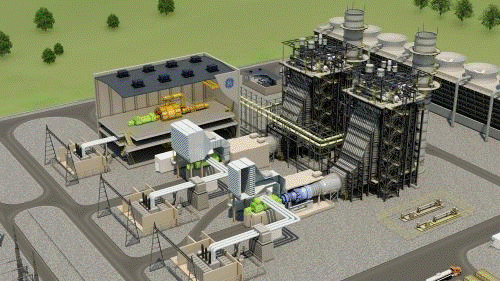

The process can be simulated with heat and material balances, complete with dynamic behavior. This is the core technology for constructing high fidelity unit specific operator training simulators. These are typically organized with a flowsheet simulator that connects unit operations with piping networks. Every stream has a temperature, pressure, flowrate, and a composition of the solid, liquid and vapor phases. Simulations are especially common in high consequence process units like major reaction systems in a refinery, a boiler, or a nuclear reactor. At the other end of the fidelity spectrum is the simple tieback simulator where controller outputs are used to compute control system measurements with highly simplified relations with little concern for fidelity.
The process spatial geometry is simulated with virtual reality technology. Where plants are designed and built with 3D CAD models, such models can be adapted to training activities for the field operators. Even without CAD models, new camera photometric and LIDAR techniques can be used to construct 3D spatial models of complex plants, equipment, or buildings. Used with gaming tools like heads up displays and X-box controllers, operators can manipulate avatars to interact with process 3D models or other operators. The interaction can involve animated equipment, live update of gauges, instruments, valves, and pumps from the process simulator. Training sessions can be coordinated with the dynamic process simulation or can be of general educational value to better understand how various field equipment functions.

The control system dynamic behavior is simulated by an emulation built into the process simulator, a virtual control system often supported by the control system vendor, or real control system equipment connected to the process simulator. The control system simulation includes the simulation of panel mounted controllers, PLC’s, DCS’s, shutdown systems, and simulation of the graphical user interface with the alarming system used by the operators. It often includes various MES related applications like data historian for trending, and supervisory programs for things like batch control, scheduling, or model predictive control. To keep a high level of realism the control system simulation can include a replica control room, and operator consoles that match the plant equipment. The nuclear power industry often constructs so-called full scope simulators, where all equipment in the main control room is simulated in a room that realistically replicates the actual control room.
You can see from the descriptions above that each of the components of an operator training simulator can vary tremendously in cost, complexity and fidelity. High consequence processes tend to use high fidelity unit specific process simulators with an accurate and realistic control system simulator where the operator must handle upsets, startups, shutdowns and various equipment failures like power fail or loss of instrument air. Sometimes generic simulators are used for new operator orientation to teach basic concepts for pumps, heat exchangers, distillation, or fired heater. Where operators must know the details of complex control or safety systems, there is little substitute for training with hands on time at the unit specific process and control simulator. Where training field operators is involved, the emerging technology of 3D virtual simulation of the spatial geometry of plants, buildings, and equipment may meet your needs.

